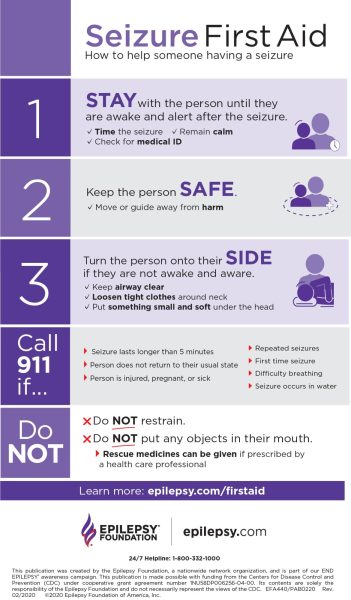November is Epilepsy Awareness Month, and the Mesa campus recently welcomed Kelley Grimes and Sarah Waters from the Epilepsy Foundation of San Diego County for an informative panel discussion to educate attendees about the causes of epilepsy, its nature and essential first aid measures.
Grimes and Waters began by explaining that epilepsy is a chronic neurological disorder, sometimes referred to as a “seizure disorder” that is characterized by a tendency to have recurrent seizures. They clarified that a diagnosis of epilepsy is made when an individual experiences more than one unprovoked seizure. An unprovoked seizure, they noted, is one that does not result from an accident or injury.
Attendees learned about the importance of recognizing seizure symptoms and the appropriate steps to take when providing first aid. While most epileptic seizures are not emergencies, on Mesa campus the guidelines are clear. Staff and faculty are to immediately call 911, campus police at (619) 388-6405 or press the emergency button in the classroom. The individual reserves the right to refuse 911 services, but only after paramedics have arrived.
During the panel, Waters emphasized that while not every seizure is an emergency, certain signs do indicate a need for immediate medical attention. These include experiencing a first-time seizure with no prior history, repeated seizures without regaining consciousness, failure to resume normal breathing, and seizures occurring in individuals who are pregnant, injured, or have diabetes. Additionally, seizures occurring in water or lasting longer than five minutes also constitute emergencies. Prompt medical intervention is essential in these situations to safeguard the individual’s health and safety.
In both emergent and non-emergent situations, Waters stressed the need for calm and composed actions, such as ensuring the person’s safety and timing the seizure. Grimes added that it is crucial to protect the individual from possible hazards, such as chairs, tables, and sharp objects. They recommended turning the person on their side, providing neck and head support with cushioning and avoiding any form of restraint. Additionally, nothing should be put inside the mouth of an individual who is seizing. These measures are vital to ensure the individual’s safety and well-being during a seizure.
In San Diego alone, 50,000 people live with a seizure disorder. In the United States, 3.4 million people have active epilepsy, including 470,000 youth aged 17 years or younger. Statistically, 1 in 26 people will develop epilepsy, and 1 in 10 people will experience a seizure in their lifetime. Epilepsy is the fourth most common neurological condition, following migraines, strokes, and Alzheimer’s disease.
Grimes went on to say that understanding these aspects of epilepsy is crucial for fostering a supportive and informed community. By raising awareness and dispelling myths, people can better support those living with this challenging condition.
The panel concluded with a Q&A segment, where participants had the opportunity to ask questions and share their experiences. The event was well-received, leaving attendees better informed and prepared to support individuals with epilepsy in their community and on campus.


